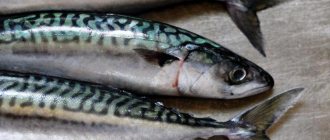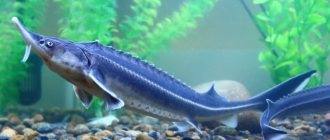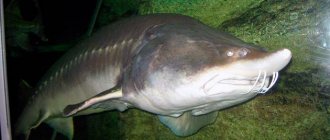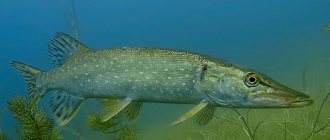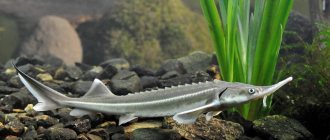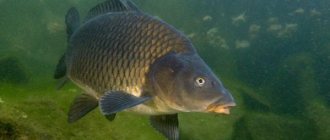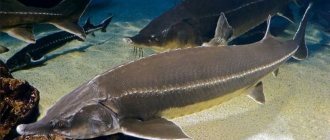In the world of the deep sea there are many amazing living organisms, some of which are fish without scales. In Judaism, they are equated with unclean reptiles, so Jews do not eat them.
Scales perform a number of important functions, including:
- Disguise;
- Protection against parasites;
- Improved streamlining;
- Increased speed, etc.
Fish without scales are forced to adapt to life in the open waters differently. For example, if there is a predatory fauna nearby, it will bury itself in the mud in an attempt to camouflage itself. But this is not the only reason for the Jews’ neglect of her. People who profess Judaism believe that the Creator could not create such representatives of the animal world in his own image, because their appearance is repulsive. And there really is a rational grain in this.
A snake-like fish with a slippery body can easily escape even from a large and fast predator. In addition, its mucus can be toxic, that is, dangerous for other aquatic inhabitants. Let's talk about some of these types.
Char
Char is a red fish without scales , which belongs to the salmon family. However, there are still very small hard plates on the surface of its body. Thanks to their presence, the char can significantly increase its swimming speed, if necessary. The fish got its name for a reason. When you look at it, you get the impression that it is completely devoid of scales, that is, naked. In part, this is true.
Loaches have a cylindrical, slightly oblong body shape. Their head is slightly flattened. A distinctive feature of this inhabitant of the aquatic expanses is its large fins. The loach also has pronounced and large lips. It is classified as a schooling fish.
The length of an average-sized individual is 20 cm, but some rare species of char are shorter, their body length is from 10 to 12 cm. The fish feeds on zoobenthophages. The main competitor of the char is the gudgeon. These fish reproduce quite quickly. The main reason for this is the unpretentiousness to water quality. Fishermen catch them using a fishing rod.
Navaga
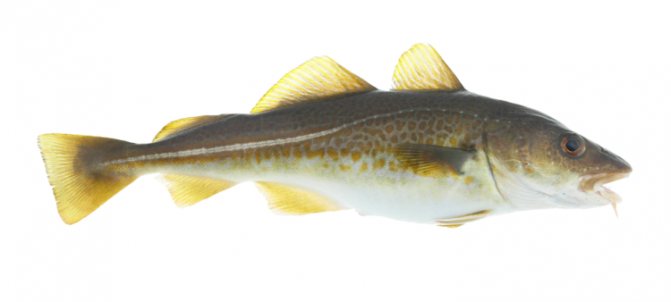
Navaga is a cold-loving sea fish; it belongs to the cod family. There are two types of this fish, northern navaga and Far Eastern, known as vakhnya . The body length of navaga usually reaches 30 cm, its weight at this length is 250 grams; there are also larger individuals, up to half a meter in length, weighing about 1 kg. The Far Eastern navaga is much larger than the northern navaga.
The body of navaga has a more rounded appearance than that of other cod, the head is smaller in size, the fish is distinguished by a peculiarity in the structure of the spine - there are peculiar swellings on its short ribs. The upper jaw of the fish is longer than the lower jaw; a single antennae is located on the lower jaw. There are many dark spots on the brown-gray back of the navaga. The sides of the fish are lighter than the back, the belly is white. The Far Eastern wahnia also has a white belly, but its back is greenish-gray and its sides are silver-violet.
Habitat
Navaga can be found from the White Sea to the Ob Bay, the Far Eastern navaga lives in the Chukchi, Bering, Okhotsk, and Japan seas. Navaga cannot be found in the open sea; it is a coastal fish. In the spring, when the water on the coast becomes too warm, it moves away from the shore a short distance in search of colder water. In the autumn-winter period, navaga moves in flocks closer to the shore; schools of Far Eastern navaga often enter lakes and river mouths. Navaga is a bottom-dwelling fish
Diet
Navaga is a predator; it feeds on eggs and juveniles of other fish, crustaceans, and various worms. In the spring, when the fish are forced to look for cold water, their nutrition is insufficient; as cold weather sets in, the navaga returns closer to the shore to fatten.
Som
The catfish, like the loach, is not completely devoid of scales, but its scales are very small and fit tightly to the surface of the body. It's hard to notice. However, even despite the lack of full-fledged hard plates, catfish is considered one of the most valuable fish in fishing. The average length of an individual is 3-4 meters, but, under favorable conditions, the catfish can grow up to 5 meters.
He is classified as an aquatic hunter. Thanks to its large mouth, this representative of the fauna easily swallows small and large fish. Its diet also includes carrion. Catfish is the largest river predator. Despite poor eyesight, he has excellent navigation in the water thanks to his long mustache.
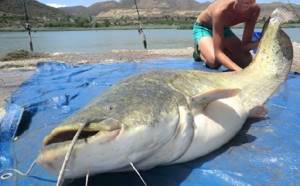
Tiny freshwater fish
One of the smallest fish that lives in freshwater reservoirs and is distinguished not only by its minimum length, but also by its insignificant body weight, is the mystichthys goby, which inhabits the wild reservoirs of the Philippines. Despite the fact that the length of this fish does not exceed 13 millimeters, it is actively consumed by local residents as food. The natives bake cakes from these bulls, which are subsequently dried and can be stored for a very long time.
In the reservoirs of Russia there is also a fish that claims to be one of the smallest fish on Earth. We are talking about a nine-spined stickleback, the maximum length of which is five centimeters. This species has a fairly large population in the waters of the Baltic states and Finland. Stickleback is a commercial object and is used for the manufacture of several types of products:
- dry animal food;
- fish oil;
- for the preparation of medicines.
https://youtube.com/watch?v=yKGQAzdzkBU
In addition, stickleback serves as the basis for food supply for more valuable commercial fish species. Some amateur fishermen catch stickleback with a fishing rod and prepare minced fish for cutlets from it. Recently, due to large-scale commercial fishing, the population of this species has decreased significantly.
Acne
This is one of the most popular river fish without scales , belonging to the serpentine family. The untrained eye may confuse it with a snake. This is not surprising, because the eel is indeed very similar to this animal, but its body is slightly thicker.
The birthplace of the eel is the well-known Bermuda Triangle. The local current picks up fish eggs, quickly carrying them into the fresh waters of European reservoirs. Interesting fact! The electric eel, when hunting, produces a lethal electric shock for medium-sized fish.
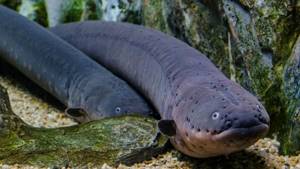
Fish without scales eel
Sturgeon
In the marine industry, this fish is one of the most popular. Scientists identify more than 10 species of sturgeon. Each of them is united by a 5-row structure of special scutes (diamond-shaped bone scales).
The second distinctive feature of the sturgeon is its cone-shaped head. The jaw of this fish moves forward easily. By the way, she has absolutely no teeth. The lips of this fish are dense and fleshy. The structure of the sturgeon is invertebrate.
Sturgeon is famous for its excellent fertility. By the way, it goes to fresh waters to spawn. They prefer to spend the winter in them. The sturgeon diet includes small inhabitants of the deep sea, such as:
- Shellfish;
- Bulls;
- Anchovy;
- Sprat.

Russian sturgeon
Golomyanka
This white fish without scales is found only in Lake Baikal. The main feature of the golomyanka is that 40% of its body is fat. This is a small but very beautiful inhabitant of Lake Baikal. The body length of this fish is from 20 to 25 cm. By the way, female golomyanka are larger than males. Scientists distinguish 2 types of this fish: large and small.
When the golomyanka swims, it seems that it flies like a butterfly. This is due to its large deployable fins located on the front of the body. Another characteristic feature of golomyanka is its transparency. However, once you pull the fish out of the water, it will appear before you in white. But that's not all. Golomyanka is one of the few fish that gives birth to live fry. Unfortunately, after giving birth, the female dies.
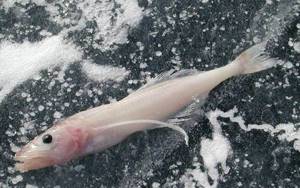
"Stray" guests
You will be surprised at what kind of fish are found in the Volga. But not everyone lives here permanently. Many fish are called migratory because they grow and fatten in the Caspian Sea, and only come to the Volga to spawn.

These species include stellate sturgeon, lamprey, sturgeon, whitefish, beluga, herring and many others. In addition, there are also semi-anadromous fish that live and feed at the very mouth or in the desalinated waters of the Caspian Sea, but rise up against the current of the Volga to spawn. These include pike perch, roach, carp, bream and others.
Mackerel
Mackerel is a pelagic marine fish without scales . However, there are small hard plates all over the surface of her body. Mackerel is considered a fairly valuable fish in the industry. Its meat is very healthy. It contains a large amount of vitamin B and fat, in addition, its meat is nourishing and tasty. Another industrial advantage of mackerel is the absence of small seeds.
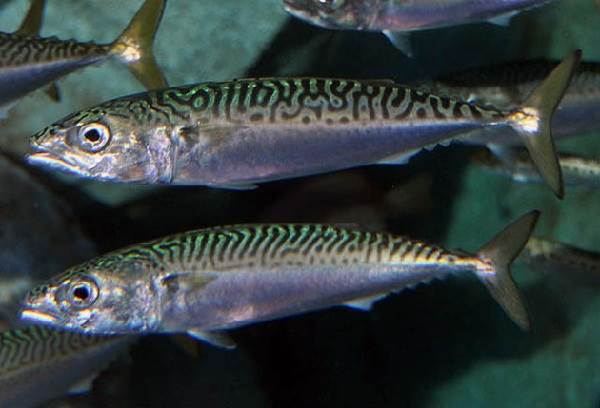
Loach
This representative of the aquatic world has a snake-like physique. The loach is colored black. There are small dark spots all over the surface of its slippery body. This fish lives only in stagnant bodies of water. An important requirement for a settlement site is the presence of a large amount of dense algae.
The loach regularly rises to the surface of the water to enrich itself with oxygen. At the same time, it makes a specific sound, reminiscent of a whistle. This representative of the fauna is distinguished by its excellent resourcefulness, which allows it to easily maneuver in the water.
Food that the loach prefers:
- Worms;
- Larvae;
- Remains of invertebrate animals;
- Cancers.
The favorite food of this fish is caviar. Interesting fact! Japanese scientists are able to predict tsunamis and typhoons based on loach maneuvers.
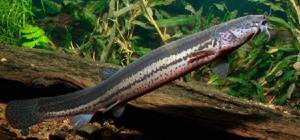
Shark
The shark is classified as a fish that lacks hard plates on its body. She has them, but their size and shape are non-standard. In structure, shark scales resemble teeth. Their shape is rhombic. Such small “teeth” fit very tightly to each other. The body of some sharks is covered with spines over the entire surface.
Why is this predator classified as a fish without scales? Everything is very simple. The hard, jagged plates covering its body are very smooth. If you look solely at the shark's skin, you might think it belongs to an elephant.
This predatory aquatic creature is famous for its razor-sharp teeth. They are shaped like a cone. A special feature of the shark is the absence of a swim bladder. But this does not prevent it from being a full-fledged fish, since maneuvers are performed thanks to the presence of fins. This aquatic predator is classified as a cold-blooded animal.

Tiger shark
White shark
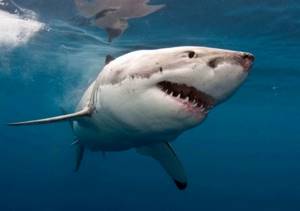
The great white shark is known to many as the man-eating shark, or carcharodon. This animal belongs to the class of cartilaginous fish and the herring shark family. Today, the population of this species slightly exceeds three thousand individuals, so the great white shark belongs to the category of predatory animals that are on the verge of extinction.
The largest of all modern predatory sharks is eleven meters or a little more in length. The most common individuals are those with a body length of no more than six meters and a weight in the range of 650-3000 kg. The back and sides of the white shark have a characteristic gray coloration with slight brownish or black tones . The surface of the ventral part is dirty white.
It is known that relatively recently white sharks existed, whose body length could reach thirty meters. Eight adults could easily fit in the mouth of such an individual, living at the end of the Tertiary period.
Lifestyle
Modern white sharks lead a predominantly solitary lifestyle. Adult individuals can be found not only in the waters of the open ocean, but also near the coastline. As a rule, the shark tries to stay close to the surface and prefers warm or moderately warm ocean waters. The white shark destroys prey with the help of very large and wide, triangular teeth. All teeth have jagged edges. Very powerful jaws allow the aquatic predator to effortlessly bite through not only cartilaginous tissue, but also fairly large bones of its prey. Hungry white sharks are not particularly picky about their food choices.
The dominance of females over males, and the largest individuals over smaller sharks predominates . Conflict situations during the hunting process are resolved by rituals or demonstrative behavior. Fights between individuals of the same population are certainly possible, but they are quite rare. As a rule, sharks of this species in conflicts limit themselves to not too strong, warning bites
A distinctive feature of the white shark is the ability to periodically raise its head above the water surface in the process of hunting and searching for prey. According to scientists, in this way the shark manages to capture odors well even at a considerable distance.
Moray
This serpentine fish without scales in the photo looks like a viper with big eyes. Under favorable conditions, the body of a moray eel can grow up to 2.5 meters. The weight of such a creature reaches 50 kg. The moray eel has no scales at all.
Its wily body is covered with a large amount of mucus, the main function of which is to protect it from large predators. When another inhabitant of the waters tries to attack a moray eel, it easily eludes him. Despite the ability to avoid fights, moray eels are quite strong fish. She often attacks divers. A meeting with her often ends in death for them.
The fin of the moray eel is elongated, therefore, the shape of its body is similar to that of an eel. Most of the time, its mouth is open. The nose of this fish is covered with small whiskers. By the way, it is the antennae of the moray eel that are the main bait for other fish, which perceive them as edible worms. Another distinctive feature of the moray eel is its sharp teeth, similar to the fangs of predators. Thanks to them, fish can easily split the durable shell of crustaceans.
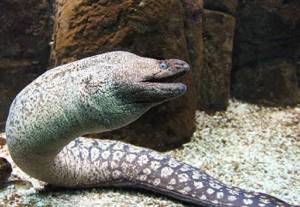
pearl fish
This aquatic inhabitant belongs to the carpus family. Pearl fish without scales got its name for a reason. According to a common interpretation, one of the pearl fishers, diving deep into the water, noticed a small snake-like fish near an oyster shell.
A long stay in such a “house” painted it the color of pearls. The small size of the fish allows it to swim into the shell. An interesting observation is that pearl fish lead a lifestyle depending on the degree of their independence.
Most often, they play the role of parasites, that is, creatures that can only live off the body of another representative of the animal world. The pearl fish prefers to settle in the anal pores of the sea cucumber. She stays there for a long time, eating his eggs. Individuals with a high level of independence prefer to enter into symbiosis with other fish.
Pearl fish are found in the waters of the Pacific, Atlantic and Indian Oceans. In the industrial sphere it is not valued for 2 reasons. Firstly, its miniature size prevents its consumption, and, secondly, the meat of pearl fish contains practically no useful substances.
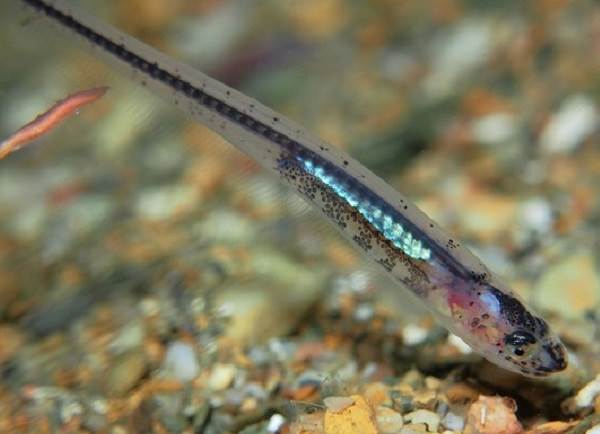
Big-headed Alepisaurus
This fish is one of the marine fish. The large-headed alepisaurus has a very thin but elongated body, on top of which there is a wide fin, the number of rays on it is from 30 to 40. The color of this representative of the deep sea is gray-silver. In the mouth of the Alepisaurus there are long, sharp, dagger-shaped teeth. It is found in the waters of all 4 oceans.
In appearance, the large-headed alepisaurus resembles a small lizard rather than a fish. Even despite the complete absence of scales, it is very rarely caught to eat. The reason is tasteless and useless meat. The big-headed alepisaurus is one of the marine predators. It feeds not only on small fish, but also on worms, mollusks, crayfish and squid.
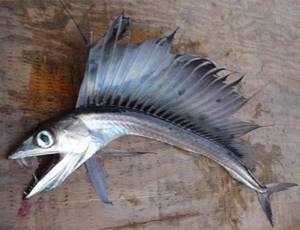
Varieties
The description and name of different types of longhorned beetle differ. The common barbel is called myron or madder. In the Neman, the whiskered fish is called a kelb, and the small males are called a redpoll.
The common barbel is a freshwater species. It lives in the basin of the Black, Baltic, Atlantic and Caspian Seas. It stays near the bottom of the river, where there is a fast current. For the winter, it digs a hole or hole near the shore. In winter he does not need food. Externally, the river fish looks like a gudgeon, catfish or madder. But it looks larger in size, with a shorter mustache. Its weight is up to 12 kilograms, its body length is on average about 90 centimeters.
There are other varieties of fish with this name:
- Aral. Lives in the Amu Darya and Syr Darya rivers. A distinctive feature is the mustache near the mouth and nose. Small eyes. With the help of whiskers it searches for prey. The lips are thick, making them less susceptible to snags and gravel. Females are larger in size, but their sexual maturation occurs more slowly than that of males. The average lifespan of this species of longhorned beetle is 19-20 years. Males become sexually mature at two years. During this period, the body length is 18 cm. Spawning occurs in late spring. It goes in search of prey at night. It feeds on mollusks, worms, insect larvae, and the eggs of other fish.
- Chanari. It is not sedentary, unlike its relatives. Lives in the Caspian Sea basin. Prefers to migrate in search of cleaner water. Chanari are the largest among the barbels. They differ externally in the structure of the dorsal fin. The teeth on it are less pronounced, blunted. The scales are golden in color and large.
- Kurinsky. Lives in the Kura River basin. In appearance, description, behavior and characteristics it does not differ from other types of myrons.
- Sevan. The dimensions are smaller - no more than 28 centimeters, body weight is about 280 g. It lives in the waters of Lake Sevan and in adjacent rivers. The basis of the diet is the caviar of other fish and insect larvae.
- Crimean. Inhabits the rivers of Crimea and the Western Caucasus. The appearance does not differ from other representatives of the species.
- Dagestan. Found in the Kuma and Terek rivers. In appearance and features it does not differ from other barbels.

Burbot
This fish has no scales, as it lives deep underwater, preferring to camouflage itself in the mud. The absence of the need for hard plates on the body of burbot is also associated with its dark habitat, and, as is known, one of the functions of scales is to reflect light.
It is almost impossible to notice this fish at the bottom of the reservoir. Burbot is one of the best camouflage fish. And their lack of scales is due to the need to maneuver in the silt. This fish is classified as freshwater. Its distinctive feature is its asymmetrical mouth. The upper jaw of the burbot is longer than the lower.
Interesting feature! The older the burbot, the lighter its body. It is known that in cool water this fish is much more active than in warm water. Its diet consists of small fish, frogs, invertebrates, crayfish and mollusks. Rarely does burbot feast on animal remains.

Burbot fish without scales
This representative of river and lake depths prefers to swim in clear water. Burbots often swim into ponds. The warmer the weather, the deeper they swim to the bottom, because the water is colder there. Burbots are valued, first of all, for their skin, which, by the way, is very easily separated from its body.
Alepisaurus
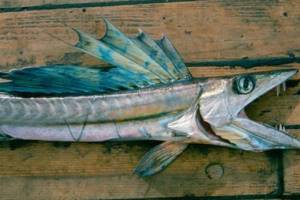
Alepisaurus is a large predatory fish belonging to the Alepisauridae family. The appearance of this creature is truly terrifying. With its large mouth with large dagger-shaped fangs, the fish resembles a daggertooth. And the huge fin makes the alepisaurus look like a sailfish.
Alepisaurs are truly creepy creatures. The toothy mouth alone is worth it. But there is also a fish body, the length of which can reach up to two meters. The body itself is narrow, its front part is slightly flattened laterally, and the tail part has a cylindrical shape. Yes, by the way, this fish really has no scales completely.
The back of the alepisaurus is decorated with a huge fin stretching along the entire body. If the fin is straightened, then it is twice as tall as its owner. The color of the fanged fish is also gloomy - black-gray-blue. There is still very little information about the reproduction of these representatives of marine fauna. But if we consider that alepisaurs are not averse to occasionally feasting on their fellow creatures, we can assume that they are generally hermaphrodites, and each individual has both female and male organs.
Story
The first mention of this sea monster dates back to 1741. Then the description of the alepisaurus was given by the famous participant of the second Kamchatka expedition, Georg Wilhelm Steller, who was lucky enough to see a specimen of a hitherto unknown fish washed ashore by a wave. Then the traveler named his find Plagyodontis. That was the end of the study of this marine inhabitant.
It was only in 1811 that interest in the alepisaurus arose again. This time, zoologist Peter-Simon Pallas, using Steller's findings and his dried find as a basis, compiled a detailed description of the fish, identifying a separate genus for it - Plagyodum. Later the name was transformed into Alepisaurus ferox, which is translated from Greek as “lizard”, “scaleless beast”.
Lifestyle
Like many fish that live in the depths, alepisaurs practice daily migrations in a vertical direction. At night they try to move closer to the surface, and during the day they return to the depths. Such “walks” are associated with the movement of food, for which alepisaurs use various types of fish, squid, octopuses and crustaceans. If food is very tight, then the predatory fish will not disdain its smaller relatives.
